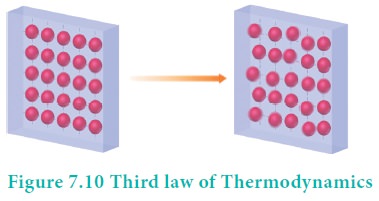Chapter: 11th Chemistry : UNIT 7 : Thermodynamics
Third law of Thermodynamics
Third
law of Thermodynamics
The entropy of a substance varies directly with
temperature. Lower the temperature, lower is the entropy. For example, water
above 1000 C at one atmosphere exists as a gas and has higher
entropy (higher disorder). The water molecules are free to roam about in the
entire container. When the system is cooled, the water vapour condenses to form
a liquid. The water molecules in liquid phase still can move about somewhat
freely. Thus the entropy of the system has decreased. On further cooling, water
freezes to form ice crystal. The water molecules in the ice crystal are highly
ordered and entropy of the system is very low.
If we cool the solid crystal still further, the vibration
of molecules held in the crystal lattice gets slower and they have very little
freedom of movement (very little disorder) and hence very small entropy.
At absolute zero (0 K or ŌłÆ 273K), theoretically all modes
of motion stop.
Absolute zero is a temperature that an object can get
arbitrarily close to but absolute zero will remain unattainable.
Thus the third law of thermodynamics states that the
entropy of pure crystalline substance at absolute zero is zero. Otherwise it
can be stated as it is impossible to lower the temperature of an object to
absolute zero in a finite number of steps. Mathematically, limTŌåÆ0
S=0 for a perfectly ordered crystalline
state.

Crystals with defects (imperfection) at absolute zero,
have entropy greater than zero.
Absolute entropy of a substance can never be negative.
Related Topics